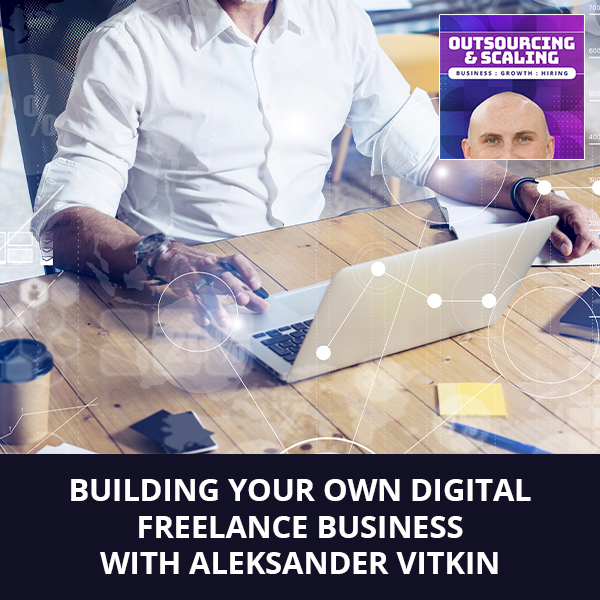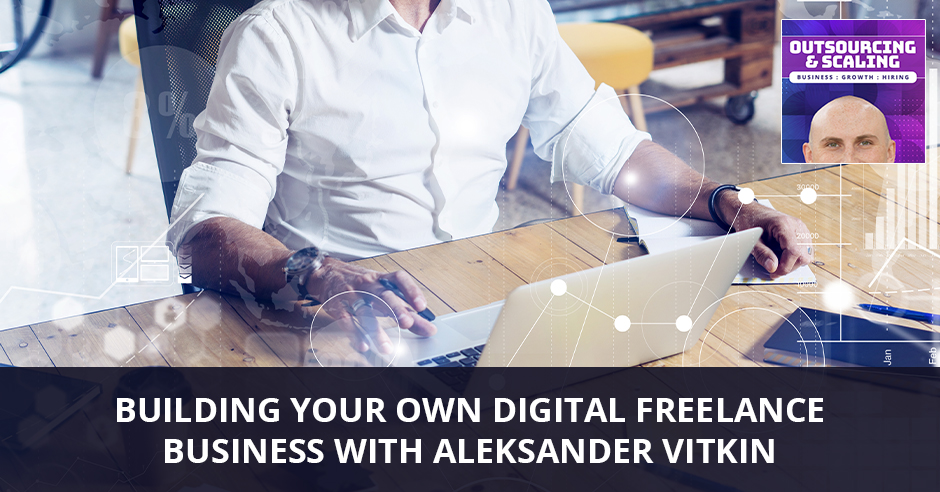


Many want to build a freelance business, but only a few really bring home the bacon. Aleksander Vitkin, the CEO of BusinessMentor.com, offers his expertise in helping you start and scale your digital venture. Diving into creating a process for a freelance business, outsourcing, and pricing, Alex offers some advice on how you can start your own freelance business – from hiring the right freelancers to marketing your niche. He also talks about the typical mistakes in the business and how to deal with different client issues. Grow your own freelance online business. Learn how in this informative episode.
—
Listen to the podcast here:
[smart_track_player url=”https://www.podetize.com/statsapi/www.podetize.com/wp-content/uploads/fileuploads/11-5b145ef137b51b3d1af0633e9305c43d/09/2019/0586df5f504d6eac736c6c7c3842c1f3.mp3″ title=”Building Your Own Digital Freelance Business with Aleksander Vitkin” artist=”Nathan Hirsch” image=”https://freeup.net/wp-content/uploads/2019/04/OAS.png” ]
Download the audio file here.
Building Your Own Digital Freelance Business with Aleksander Vitkin
My guest is Aleks Vitkin. Aleks, how are you doing?
Thank you for having me. I’m doing fantastically well and I really appreciate your time.
We appreciate yours as well. For those of you that don’t know, Aleks has helped over 700 people with a sincere interest in entrepreneurship and contribution to start profitable businesses, quit their jobs, and travel the world. Aleks teaches freelancers and agencies to build a business, which is what we’re all about if you’ve read our blog. Aleks, we’re going to talk about all of that but before, I want to take a step back. What were you doing before all this? Talk to us about growing up and how you got into entrepreneurship.
I always had this weird vision as a kid that somehow I was going to end up in this boardroom with a CEO and I was going to advise them. I know it’s a very strange fantasy to have for a seven-year-old, but for some reason, I must’ve seen it in some movie somewhere. I had this weird vision and it didn’t come to fruition until I graduated from college and I studied business. I graduated college and everyone was getting jobs and they were saying, “Aleks, what is your career going to be?” I thought, “I don’t want this. I did internships. They were fun and all, but I don’t feel like I’m doing what I’m supposed to be doing with my life.” I’m reading all these entrepreneurship books so I’m going to go straight into business as a consultant from day one. This was 2008 to 2009. It must’ve been quite funny to my friends and the first couple of years they were 100% right.
It was a failure because I lost more money than I made. Over the next few years, I learned how to do it successfully. I started traveling as well. I had a job for a few months, but after that, I quit forever and never had a job again. I ended up building several businesses like dropshipping, SEO websites and running an agency. Some of those were quite successful, others not so much. At a certain point, a few years into my business career, I figured out that the people want to learn from me, how I’m traveling the world and how I’m building a business. I started a YouTube channel and then I started consulting people on that one–on–one. I started this thing called Daily Business Hustle back then that eventually turned into BusinessMentor.com. Now, there are 227 people in there. It’s a worldwide community of entrepreneurs and people join, we teach them business skills, and they end up going from having a freelancer career or a job to running an agency for marketing and creatives.
Let’s talk about that because that’s something that I preach. We obviously have a lot of freelancers on the FreeeUp platform. Getting in the mentality of looking at yourself as a business and not just working for someone else in a remote job is usually the first step to having more success and really scaling. Where do you see people failing and how do you get people into that mentality?
The way I see people failing, especially if they’re freelancers, is they end up doing all these different gigs for different clients that are totally different from each other. I did a little bit of SEO, a little bit of Google ads, a little bit of this, that, and the other thing. They ended up filling in positions in people’s companies instead of building their own process and a single service that they deliver in a factory environment. Instead of creating a process, creating a business, they ended up doing a bunch of different projects that are unrelated to each other so they are essentially running three or four different tiny little businesses. At the same time, they’re not building any assets for themselves, so they’re building someone else’s business. They’re not building their own business. They’re building someone else’s email list, but they’re not building their own email list.
They’re building someone else’s wealth and for themselves, they’re not getting that much in return. They’re getting an hourly rate usually. If you want to get it out of that, you need to learn several new skills. You need to learn how to create these processes. You learn how to close sales properly so that you’re not running from a project that you don’t really want to do to another project that you want to do to actually choosing your clients, choosing who you work with and be an absolute expert in creating a business that’s an absolute top of the line in delivering a certain type of result to a certain type of client. Doing everything for everyone versus being the go–to business for a certain type of solution. These are two very different things that are running in very different ways.
When you’re closing a contract, make sure the client knows exactly how and when communications are going to happen.
Let’s talk about building your own processes because I think that’s where a lot of freelancers struggle. They’re always looking to do things the way that the client wants it. You talked a little bit about niching down. How does someone go about creating processes for their freelance business?
First of all, build up some skill level by freelancing. There’s nothing wrong with a little bit of freelancing. Do that for a while and have ten, twenty clients over a year, maybe a year–and–a–half and then go back and look at your best-performing clients. Look at the clients that did better than most, that you liked working with the most, that referred you to most business and that didn’t require babysitting. Drop all the other clients that are wasting your time, not getting results and so on and focus only on that 20% that are the best clients that you want to work with. Once you have that, once you’ve niched down, then the real fun can begin. You can start giving away parts of the processes that you’re running so you’re doing things every day.
You’re doing lead generation, you’re doing sales calls, you’re doing the delivery, all kinds of stuff, client management. Start with the easiest skills first or rather the easiest processes first, let’s say lead generation. Give that away to a VA, they’re not that expensive. Once you have a VA doing lead generation, for example, you suddenly have five to ten hours extra per week to work on your business instead of being a lead generation freelancer in your own business. You outsourced that for $5 to $15 an hour. Suddenly you have a bunch of time, then you have the next thing. Let’s say it’s delivery. You’re running a Facebook ads agency. What can you do to outsource delivery? How can you find experts that are doing Facebook? You give them 30% of the project fee and you’ll say you are in charge of delivery here.
For this, you need to be able to charge a lot of money obviously. If 30% is barely any money, no one good is going to want to work with you. Once you have that figured out, you have lead generation and you have delivery outsourced. You have a tiny little team, two people working for you that are doing those two things. Suddenly, you have 25 hours a week extra to spend on your business instead of being a freelancer in your own business. You go on do the same thing with client management and eventually even with sales. What are you doing then? Once you have those four or five things, once they’re handled by virtual assistants or staff on location, what do you do with your time? You’re building your business and you’re not running around extinguishing fires all the time. You’re overseeing and managing a process that works. You’re improving that process, but most of your time is spent on creating your processes and funnels, scaling, all the cool fun stuff that gets people from doing $5,000 per month as a freelancer to $50,000 and above as a business owner. That’s the super-fast summary of how to do it.
I love the process and we actually have a lot of freelancers on the FreeeUp platform that are also clients of the FreeeUp platform and they’re hiring virtual assistants for lead generation or handle certain parts of their business. They’re obviously upfront and transparent with the client if they’re going to be outsourcing anything, but we encourage people to make that transition from a freelancer to agency, assuming the clients are good with it and they are transparent. Let’s talk about pricing. How does someone go about pricing themselves accordingly? Talk about both, let’s say someone is getting into freelancing for the first time, how do they figure out their prices opposed to someone who’s really becoming a specialist and an expert?
Someone who is a complete beginner and they want to freelance, the solution is relatively easy. Go look at the other freelancers that are performing the same service and go down the middle of something in terms of average pricing. It’s in the real world, not what they see under profiles or whatever. In the real world if they’re charging $25 an hour, start charging $25 an hour as a freelancer. Don’t charge less than that. Don’t charge less than the average of people working from Western countries and doing the same type of service you’re doing. That’s only for beginners. Once people come to me and they want to learn how to build a business, I say absolutely under no circumstances do what I just said. In fact, do exactly the opposite. Don’t look at anyone else and start charging fees that are not hourly at all.
Start charging fees that are monthly recurring based on a contract. Start locking people down on a three-month contract or so. I’ve seen people even do twelve months. If you’re delivering an awesome service that delivers results, there’s nothing wrong with that. In fact, it increases client results. Start locking clients down on three months contracts or more and start charging thousands of dollars. That’s for a single service. If you do one service, a good example is Facebook ads. If you know that in the industry, a decent agency charges $2,500. You can charge $2,500 to $4,000 as long as you deliver great results. You can keep increasing that as the results improve for your clients. You can even attach things like profit shares, revenue shares or even equity. I’ve even seen some insanely good media buyers get equity in some businesses.
That’s how you do it as an intermediate or advanced. Make sure that under no circumstance you always charge enough so 30% of the money can go to amazing delivery if you’re outsourcing it. Whatever that number is that needs to pay your outsourcers, make sure that’s no more than 30%. It definitely needs to charge it enough. Trust me, people almost never charge enough. They always think, “Everyone else is charging $25 an hour. Everyone else is charging $700 per hour.” I can assure you that is not true. I can assure you that once someone who knows what they’re doing gets a great lead on a call, they could figure out that’s a great lead. The great lead is going to pay them more than anything they’ve listed in any profile, anything they’ve posted publicly because what you need to be doing is value-based pricing. How much value can you deliver?

Use that as a base number to calculate how much you can charge. If you deliver let’s say $10,000 for a $1,000 ad spend, that is a huge ROI that the client is getting so you can charge a lot more than a year delivering one-to-one if you’re breaking even for them. Once you start niching down, once you start figuring out your ideal client avatar, you can very easily figure out the delivery. You’re simplifying your life, you’re simplifying your service, you’re simplifying your business, and you’re improving your results. Once you have that figured out, the pricing goes through the roof. That’s how you see agencies go to $500,000 a year and over $1 million a year. It’s not easy to do, but once you’ve figured it out, it’s like magic, especially as your portfolio and your proof grow because smart buyers depend on the proof. There are only two real questions that matter. Who do you work with and what are the results? That’s what smart buyers want to know, buyers with money.
I want to talk about customer service because, in my opinion, this is where I see a lot of freelancers go wrong. You might get nine out of ten clients being awesome and one is a little bit difficult. How do you deal with that difficult issue? How do you deal with maybe you made a mistake or client’s not getting the results that you want? What’s your mentality in dealing with those issues as they come up?
This depends. For me, there are two business models that agencies succeed. It’s the McDonald’s business model and that highly-customized, very high–ticket business model. McDonald’s business model is where you offer relatively cheap services with limited customer support. If a client is not happy, you drop immediately. Don’t talk to them more than a little bit of chatting. Talk to them a tiny little bit. If they’re difficult, drop them. If you’re not getting any results, drop them, but have a lot of clients. That’s the McDonald’s model. If you deliver, most clients will never even talk to you. They don’t need to. They’re getting their sales, they’re getting the results. There’s no need for advanced customer support. People think that every business needs customer support. This is not true. In fact, most businesses don’t focus on customer support. It’s not necessary.
There’s the utter model and that is the highly-customized super high–ticket business model. Let’s say you offer three services. You do $750,000 a year and you charge $5,000 to $7,500 for both Facebook ads and Google ads, for example, as a service on a monthly basis plus a small profit share on the backend. How do you do customer support? Let’s say a customer has an issue. What people do is they have these emails back and forth. They have these angry message exchanges and all this stuff. Forget all that. In the beginning when you’re closing the contract, make sure that the client knows exactly how the communication is going to happen. When is communication going to happen? Who is the communication going to happen with? Under which situations the communication happens? It doesn’t mean if they want some random advice on some random little thing that they get a sale, that they get another one-hour call or something like that.
It means if a serious issue arises where the account gets shut down or something like that, then within 48 hours, a call can be arranged. For example, let’s say they want to call every few days at random times and the contract would say the calls happen on Tuesday at 5:00 PM every single week and we have it all in our calendars. We show up on time and that’s where we discuss all the issues. We don’t chat throughout the week. We discuss it all on this call, so write down everything or put them in our ticketing system. On Tuesday at 5:00 PM, that is when we discuss everything. If people break the rule, then you’re constantly running around and extinguishing fires. If people adhere to this, it can be all done 100 times more efficiently. It doesn’t mean not being available ever. It means to have clear boundaries with clients because it’s in their benefit.
If you as the business owner have to be available on WhatsApp, phone call, Skype 24/7, you’re not going to get any sleep. You’re not going to be able to focus on the results. You’re not going to be able to focus on executing your strategy that has been proven to work for dozens of clients. You’re going to be running around and doing random stuff. You’re going to be running around and doing stuff that doesn’t produce any results and at the end of the day, clients hire you to get results. As the agency owner, the expert, you are supposed to be guiding them through the process. That includes communication, expectation management and so on. That’s for the high–ticket business model, two different business models with different focuses here.
I think you and I agree on some stuff in terms of dropping client and customer service. We’re totally fine, but I’m 100% on board with the expectations. When I see clients and freelancers having issues or freelancers coming to me saying, “This client is bothering me too much, they’re texting me after dinner.” It’s always like, “What expectations did you set upfront? Did you establish when you’re going to be meeting, when they can and can’t contact you and what your communication is?” The answer is almost always no. Once you start giving a client a little bit of leeway, it’s very tough to reel them back in and reset those expectations right from the beginning. Let’s talk about scaling the agency. Let’s say you have a smaller team. You’re giving away that 30%. What’s the next step from there to really take your agency to let’s say $500,000 or $1 million-plus business?
To get $500,000 is one thing, beyond $1 million we’ll talk about it. To get it to $500,000, it’s ultra-niched down. It depends on the type of agency. Let’s say you sell ads. If you run ads, you go from doing retainers to selling leads if you want to get to $500,000. Once you do selling leads instead of selling retainers, it’s selling a service, then scaling becomes much less of a problem because you always have funnels running. There are always leads coming. When you get a prospect on a sales call, it’s not about proving to me this, prove to me that. It’s like, “Here are the leads. Do you want ten to see if they’re of good quality? Here you go. Do you like them? Do you want to buy 100 a week? Yes. Sign up. There you go, done.”
Once you start figuring out your ideal client avatar, you can very easily figure out the delivery.
That’s how you scale to $500,000, complete automation, almost hands-off experience and scalability because the funnel is always running. You’re not constantly building a new funnel for every single client. That’s how you scale to $500,000. You can scale this to beyond $1 million, but I recommend something else. I don’t know if you’re going to like this, Nathan, to be honest. The thing I’d recommend to scale past $1 million is to drop the agency. Instead of running an agency beyond the $1 million, learn from your clients and learn the business models that they’re running. Keep running the agency with a manager, who you give another 20% to. They run the agency and they bankroll your next business model. I don’t work with people who have agencies because we found that oftentimes when someone has run an agency for long enough to get up to seven figures, they don’t have to run an agency anymore. I don’t know if you’re going to like this.
Are you talking about stealing the client’s business model?
You are not stealing anyone’s business models. If you work with 20, 30 clients, let’s say, who are running eCommerce brands for a couple of years, you know exactly what works. You know exactly what type of targeting works. You know exactly what is in demand and in the market. You can make deals with your clients, get a small percentage of your business. I’ve seen people make 5% equity deals and that you can use their teams, you can use their marketing strategy, everything. You can build a type of business that the clients are running.
You can do this if you have enough experience by working with a few dozen clients and if you have great marketing skills and so on, you can do that. To be perfectly honest with you, once the agency hits $500,000 and you’re taking 30% to 50% of that as your profit with a manager running the agency, that’s enough to bankroll your next business model depending on what it is. Oftentimes, those are more scalable and explosively scalable business models. I don’t like that as that way. I would like just to say, “Do agency forever,” but we found based on cold hard data that going to the next business model simply works better. For you Nathan, someone would go from running an agency or being a freelancer to becoming a client on your platform and hiring a bunch of agencies of their own. It’s good for everyone.
You’re really talking about creating a business partnership with that client.
You’re creating a business partnership with the client and building a similar business that doesn’t compete with them or straight up building a whole business like what they have without stealing anything. There’s no borrowing lists or retargeting, none of that stuff. I’m talking about doing it ethically and morally.
You’re saying if you work for an eCommerce client and you get so good, you’re growing an agency for eCommerce clients to also run an eCommerce business to go along with that agency.
Absolutely. Yes, exactly.

This has been great, Aleks. Where can people find out more about you?
We have a huge amount of case studies. For anyone interested in any of these methods or business models that I’ve discussed, you can go to BusinessMentor.com and you click on reviews or if you go to BusinessMentor.com/clientminusresults, then you will find 200–plus case studies of how people have done exactly what I’ve been talking about here. Take a look at that. If you want to reach out to me personally, you can reach out to my personal Facebook profile and that is Aleksander Vitkin on Facebook. I’ll personally reply to you oftentimes.
Thank you so much for joining us. This was awesome. I know a lot of the freelancers are definitely going to appreciate this. I look forward to working with you in your community going forward.
Important Links:
- Aleks Vitkin
- YouTube – Aleksander Vitkin
- BusinessMentor.com
- BusinessMentor.com/clientminusresults
- Aleksander Vitkin – Facebook
About Alex Vitkin
 Alex Vitkin He has helped over 700 people with sincere interests in entrepreneurship and contribution to start profitable businesses, quit their jobs and travel the world. Alex teaches freelancers and agencies to build a business.
Alex Vitkin He has helped over 700 people with sincere interests in entrepreneurship and contribution to start profitable businesses, quit their jobs and travel the world. Alex teaches freelancers and agencies to build a business.
